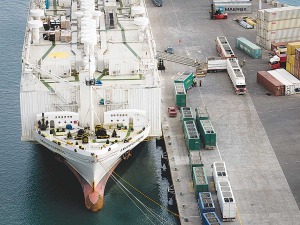MPI defends cost of new biosecurity lab
The head of the Ministry for Primary Industries (MPI) biosecurity operation, Stuart Anderson, has defended the cost and the need for a Plant Healht and Environment Laboratory (PHEL) being built in Auckland.
 Some 40,000 cattle have been exported this year with another 28,000 planned to go in the months ahead.
Some 40,000 cattle have been exported this year with another 28,000 planned to go in the months ahead.
OPINION: The decision by Ministry for Primary Industries (MPI) to impose an immediate halt to live animal exports in the wake the sinking of the Gulf Livestock 1 off the coast of Japan is a sensible move.
One would hope this is properly used as a pragmatic opportunity to review what exactly happened in this tragic case. It should not be used as some covert move to end this valuable export trade to appease overly excited animal activists and get this issue off the political agenda.
The ship left Napier on August with 43 crew including two New Zealanders and 6000 cattle bound for China. As Rural News went to press, still only two survivors and one dead crew member from the ship had been found. Let’s not forget, 40 people are still missing.
MPI says it wants to be assured that before there are any decisions about another shipment that it knows what took place on the Gulf Livestock 1 in more detail. That is not only sensible, but the right thing to. The sinking of the ship and the loss of the crew is tragic.
But this shouldn’t be used as some underhand tactic to end the trade of live animals for export. It is a lucrative, safe and important market for NZ.
Claims about high death rates and terrible conditions on board made by animal activists are not borne out by the facts. The cattle on these ships are well looked after on their voyage, fed high-quality feed and given veterinary supervision. The mortality rate is around 0.1%, which is no higher than the death rate if they stayed in NZ. These cattle are sent for breeding purposes, not slaughter and would most likely have been killed as bobby calves in NZ if they had not been sent for export.
This year alone, some 40,000 cattle have been exported with another 28,000 planned to go in the months ahead. The price of $1,400 a heifer is almost double what the same beast would make in NZ.
Yes, we need to ensure that any live exports from NZ meet the highest animal welfare and human safety conditions.
However, we must not allow the emotion of this tragic event or political activism over-rule a lawful, ethical, safe and financially viable option for the NZ livestock sector.
Ravensdown has announced a collaboration with Kiwi icon, Footrot Flats in an effort to bring humour, heart, and connection to the forefront of the farming sector.
Forest & Bird's Kiwi Conservation Club is inviting New Zealanders of all ages to embrace the outdoors with its Summer Adventure Challenges.
Grace Su, a recent optometry graduate from the University of Auckland, is moving to Tauranga to start work in a practice where she worked while participating in the university's Rural Health Interprofessional Programme (RHIP).
Two farmers and two farming companies were recently convicted and fined a total of $108,000 for environmental offending.
According to Ravensdown's most recent Market Outlook report, a combination of geopolitical movements and volatile market responses are impacting the global fertiliser landscape.
Environment Canterbury, alongside industry partners and a group of farmers, is encouraging farmers to consider composting as an environmentally friendly alternative to offal pits.

OPINION: The release of the Natural Environment Bill and Planning Bill to replace the Resource Management Act is a red-letter day…
OPINION: Federated Farmers has launched a new campaign, swapping ‘The Twelve Days of Christmas’ for ‘The Twelve Pests of Christmas’ to…